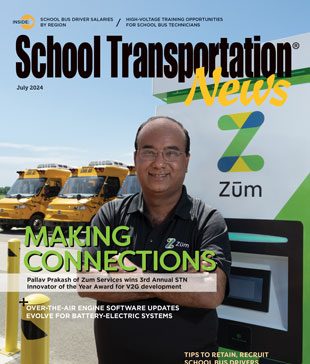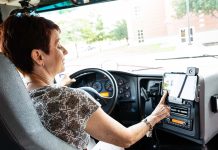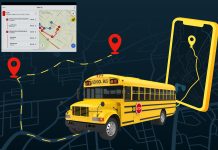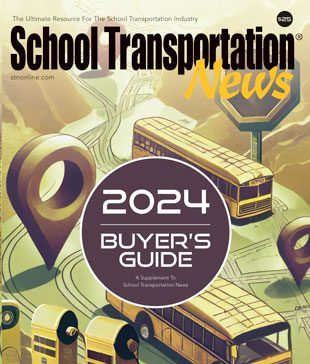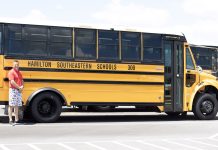Read more news coverage on school bus safety here.
School Bus Safety Data | Loading and Unloading | U.S. School Bus Stop Arm Laws | Federal Actions | Driver Distraction | Train-School Bus Crashes | State Laws on Van Usage
School Bus Safety Data
The following information from the National Academy of Sciences, the U.S. Department of Transportation and the school transportation industry reflect and represent safety data at a glance regarding yellow school buses and school transportation programs within the United States.
-
-
- About 480,000 yellow school buses provide transportation service daily nationwide.
- Approximately 26 million elementary and secondary school children ride school buses daily throughout the United States, twice a day.
- That is more than 52 million student trips daily—before adding an estimated 5 million for daily extracurricular activity roundtrips.
- This equals more than 10 billion individual student rides, or 20 billion boardings and exits, annually, when you include the national estimate for activity trips, Head Start transportation, summer school and child care transportation.
- School buses travel approximately 4.4 billion miles each school year across the United States. To put this in perspective, the U.S. Department of Transportation publishes figures that show Americans drive nearly 3 trillion miles on U.S. highways each year.
- Approximately 53 percent of all K-12 students in the country ride yellow school buses.
- The average school bus transports 54 student passengers. An average of 1.5 students are transported per car if a school bus is not available. The number of cars needed to transport students currently riding on one school bus is 36. (Source: American School Bus Council.)
- According to the National Safety Council, the national school bus accident rate is 0.01 per 100 million miles traveled, compared to 0.04 for trains, 0.06 for commercial aviation and 0.96 for other passenger vehicles.
- The U.S. Department of Transportation reported that 328 crashes involving school buses, defined as resulting in a fatality, bodily injury requiring immediate medical attention away from the scene, or at least one of the involved vehicles being towed, occurred from 2013 through 2015. This equates to an average of 109 school bus-related crashes nationwide each year, or 0.60 per day based on a 180-day school year.
- Therefore, the federal government considers school buses to be about nine times safer than other passenger vehicles during the normal school commute.
- The National Highway Traffic Safety Administration reports that 96 percent of the estimated 8,500 to 12,000 children injured in school bus accidents annually are considered minor (scrapes, bumps, bruises, etc.).
- NHTSA calculated that 4 percent of the school bus-related injuries to children—about 350 to 475 annually—are serious (i.e. broken bones or worse) based on the medical community’s widely-accepted Abbreviated Injury Scale, or AIS.
- An average of fourchildren are fatally injured inside school buses annually, per NHTSA.
- About 16 children are fatally injured as pedestrians in the loading and unloading zone around school buses annually. That is better than 200 percent improvement from 75 school bus fatalities in 1975, but is still not good enough.
- During the seven years between 1989 and 1996, 9,500 school-age children were killed during school hours while riding in all kinds of motor vehicles.
- The federal government considers school buses to be about nine times safer than other passenger vehicles during the normal school commute.
- According to data gathered for NHTSA’s Fatal Analysis Reporting System, about 600 school age children are killed annually riding to and from school in motor vehicles other than school buses. These fatalities occur during school transport hours (7 to 9 a.m. and 3 to 5 p.m.), on school days (Monday through Friday) only, and during the typical 180 day school year, to children riding to and from school, mostly in automobiles.
- More than $6 billion in state funding is spent each school year for all public school K-12 transportation.
- Several hundred pupil transportation delegates are appointed by the chief school officer in each state meet for a week-long conference once every five years to review and rewrite minimum standards and specifications for safe operation. The next National Congress on School Transportation is scheduled for May 2020 in Des Moines, Iowa.
- Three-point lap/shoulder occupant restraint systems are required by federal regulation on all newly manufactured small school buses under 10,000 lbs., but only seven states mandate their use. As a matter of practice, however, all manufacturers of small school buses install lap/shoulder belt occupant restraint systems on their buses.
- Three states—New York, New Jersey and Florida—currently require two-point lap belts on large school buses over 10,000 pounds.
- New Jersey not only requires lap belt installation on new large school buses, but students are also required to use them. In New York, use is only required if the local school district adopts a policy mandating their use. At last count, about 25 of the 725 districts in the state have done so.
- A law requiring lap belts is also active in Louisiana, but there has yet to be any appropriated funding for the restraint systems. Meanwhile, Texas had a law requiring 3-point lap/shoulder belts on all newly manufactured school buses by Sept. 2010, but the legislature never passed the necessary funding to enforce it. A new law passed in 2017 allows school boards to opt out of the requirement if it holds a public meeting that informs local residents there is no funding.
- California has the oldest three-point lap/shoulder belt occupant restraint systems law for all large school buses, dating back to 2005. It also requires three-point lap/shoulder belt occupant restraint systems on small school buses. All students are required to use the seat belts. Nevada passed a law in 2017 to require lap-shoulder seat belts on all new buses as of July 1, 2019. The law also requires student usage.
- Great Britain requires lap belts on minivans used in youth transport, including school transport. The European Union (EU) has begun to require that coaches and minivans in member states be equipped with occupant restraint systems. Congress was debating mandatory lap/shoulder occupant restraint systems for the U.S. motorcoach industry.
-
Editor’s Note: Unless otherwise noted, data presented here is extrapolated from the annual STN Buyer’s Guide that publishes state-submitted information.
Loading and Unloading
The National School Bus Loading and Unloading Survey is a collection of fatality accident records provided by the state agencies responsible for school transportation safety and/or accident records. Only those fatality accidents involving K-12 school children in or around the loading or unloading areas of a school bus or transit bus are included in this survey.
Fatalities that occur on-board a school bus are not reported here. Student fatalities that occur at a bus stop before or after the bus has departed are not listed. Neither are fatalities that occur on the way to or from the bus stop, nor those that occur to motorists who strike, or are struck by, a school bus.
Compiled annually by the School Bus Safety Unit at the Kansas Department of Education (and previously the Kansas Department of Transportation), this series started with the 1970-1971 school year. Over the 40-plus years of this series, 66 percent of the fatalities occured to students ages 2 to 9 years of age.
Students departing the bus or on their way home from school experienced 60 percent of all fatalities. School buses were the cause of 57 percent of the total fatalities while motorists who passed a stopped school buses with its red light flashing, struck and killed nearly 39 percent of the total fatilities. The report indicates “other information” accounts for the remaining four percent.
The survey shows fatalities that occur going to school, coming home, on activity trips, and by motorists that pass a school bus that has stopped to load or unload school children. Survey results are usually released in December for the previous school year. Fatalities during activity trip transportation are not included since only six occured during the three decades reported.
One activity trip-related fatality occured in 1970, 1973, 1974, 1990, and one in 2005; two occured in 1978. Fatalities involving school children that occur on public transit buses have only been included since 1996. The data is spotty since the public transit industry does not report for this study.
There has also been an argument within the school transportation industry of what constitutes a loading/unloading fatality or injury. Historically, only fatalities were reported by states that occurred when the bus was at the stop.
But news reports nationwide chronicle all-too frequent instances of child deaths occuring minutes before or after the school bus is on scene. School Transportation News compiles its own data based on these news reports.
For the 2009-2010 school year, STN found twice as many accounts of student deaths at or near the school bus stop as the 13 student fatalities reported by the Kansas State Department of Education.
Related: Selecting School Bus Stop Locations
U.S. School Bus Stop Arm Laws
A breakdown of states that have laws authorizing school districts to install video surveillance cameras on or near stop arm equipment to capture incidences of motorists who illegally pass school buses while loading or unloading students. See the color code, below, and view a summary of current state laws, as compiled by the National Conference of State Legislatures.
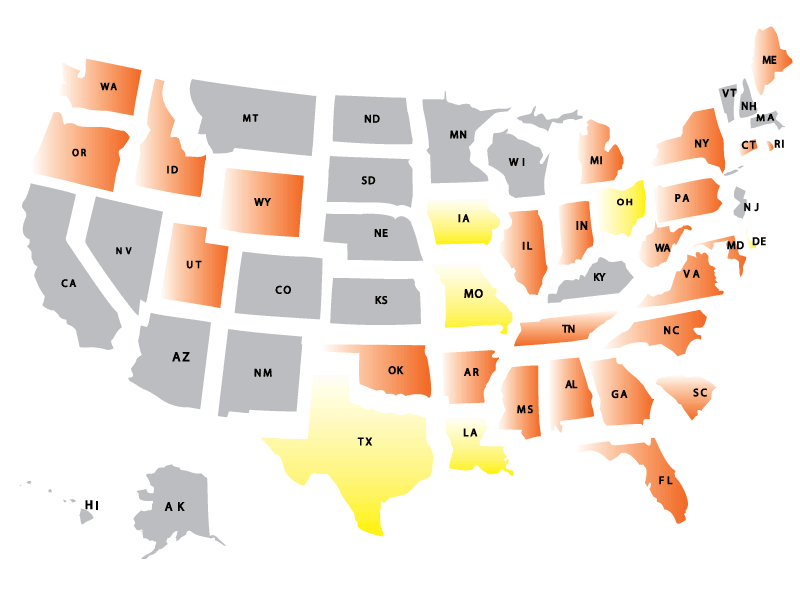
Orange = Law enacted
Yellow = Individual school districts or municipality decision
*Sources: STN, National Conference on State Legislatures. As of 7/24/24.
Federal Actions
The federal government of the United States has slowly begun to pay attention to the security of school bus transportation. Listed here are links to the federal initiatives taken to date:
-
-
- TSA School Bus Threat Assessment
Ordered by Congress as a result of the 9/11 Commission Report, TSA completed a security assessment on the vulnerabilities of school bus security in 2010. The report is not for public consumption but can be requested by school district and school bus operator personnel through a direct appeal to TSA - The Intermodal Security Training and Exercise Program (I-STEP)
The TSA’s Intermodal Security Training and Exercise Program provides exercise, training and security planning tools and services to the transportation community, including to school districts and private bus companies for student transportation - Transportation Security Administration Makes School Bus Drivers Eligible Under New First Observer Trucking Security Program:
Train-the-trainer curriculum available (July 2009) - Federal Transit Administration Decisions on School Buses
(March 2016) - TSA Employee Guide to School Bus Security
- Department of Homeland Security Announces Additional $21 Million Grant in Partnership with American Trucking Association:
(Sept 13, 2004) Funds enabled the School Bus Watch driver training program, the precursor to First Observer - USA Patriots Act, H.R. 3162 Section 801 “Terrorist Attacks and Other Acts of Violence Against Mass Transportation Systems, (C) (5):
“The term ‘mass transportation’ … shall include school bus …” - The Relative Risks of School Travel: A National Perspective and Guidance for Local Community Risk Assessment (July 25, 2002)
Report by the Transportation Research Board submitted to the Subcommittee on Highways and Transit, Committee on Transportation and Infrastructure, U.S. House of Representatives - 801 Terrorist Attacks and Other Acts of Violence Against Mass Transportation Systems:
(Chapter 97 of title 18, U.S. Code, Sec. 1993)
- TSA School Bus Threat Assessment
-
Driver Distraction
What is distracted driving?
Nearly everyone in today’s society has a cell phone or some portable electronic device designed to communicate with others or entertain ourselves. Despite a growing number of states that have passed laws banning hand-held cell phone usage while driving, just take a look around you on the road and you’re likely to see dozens of other motorists with their phone to the ear while driving. Or, worse yet, they’re texting.
Virginia Tech Transportation Institute research shows that distracted driving increases the risk of a crash by 23 times, or 23,000 percent. Data from the Liberty Mutual Research Institute for Safety has shown that driver distraction can lead to fewer mirror checks and not seeing things that are otherwise visible to all others, a phenomenon known as inattentional blindness.
The U.S. Department of Transportation has taken notice and targeted high rates of distracted driving by all motorists and especially school bus drivers. In September 2009, Transportation Secretary Ray LaHood hosted a two-day summit in Washington, D.C., that brought together federal and state officials, politicians, safety experts, representatives of the telecommunications industry, and concerned members of the public, to discuss the topic, the often-times fatal results of distracted driving and what to do do stop it.
In response to data-filled testimony and heart-wrenching accounts of fatalities at the hands of distracted drivers, LaHood announced that legislation was being worked on in Congress that would revoke commercial driver’s licenses from anyone convicted of texting while driving and that would ban all newly-licensed divers from using cell phones in personal vehicles.
In July 2009, the Avoiding Life-Endangering and Reckless Texting by Drivers Act, or the ALERT Drivers Act, was introduced that would ban all cell phone or mobile device texting by motorists including commercial drivers. If passed, states would need to adopt the guidelines or forfeit 25 percent of its federal highway safety funds.
Meanwhile, the FMCSA has implemented a final rule that makes it illegal for all interstate commercial drivers to text or use hands-free or hand-held mobile communications devices. Check out an FAQ from J.J. Keller that breaks down the what the rule means. Note: most school bus drivers are not considered interstate commercial drivers, though some who work for a private bus company with a DOT number may need to comply with the rule.
The list of states that ban cell phone usage or texting by all motorists, including school bus drivers, is on the rise, according to the Insurance Institute for Highway Safety. But, the Department of Transportation says any cell phone ban legislation should include requirements for in-vehicle or other voice-activated systems that are proven to be less risky than using other hands-free technology such as headsets, as these voice-activated systems do not require any “eyes off the road time.”
The National Transportation Safety Board issued recommendations that all states and D.C. initiate laws that ban all hand-held and hands-free mobile communication usage, including texting, email and updating social networking sites. But NTSB’s recommendations are only that and carry no regulatory weight.
Train-School Bus Crashes
There have been about 170 train-school bus collisions known to have occurred between 1902 and 2019, the most recent on record occurred in Athens, Texas. Three people were on a school bus when it crossed railroad tracks and a Pacific Union Train hit it.
The crossing section did not have a crossing guard, alarms or warning bells. The bus driver and student were ejected, the student was pronounced dead at the scene. The remaining student was trapped in the bus.
A similar crash in 2015 in Larimore, North Dakota, happened when a freight train collided with a school bus, ejecting and killing the bus driver and a high school student. Prior to that incident, a freight train in Conasauga, Tennessee, was traveling at 51 mph when it struck the passenger side of a Murray County, Georgia, School District bus that was crossing the rail grade. Another major crash occurred several years earlier in Fox River Grove, Illinois.
Of these crashes documented during the 20th century, 35 resulted in fatalities to school bus passengers, resulting in 192 deaths and at least 546 injuries (some reports only indicate “many injuries”). The first known train-school vehicle collision occurred in 1902, when a train rammed a horse-drawn stagecoach in school transportation service, resulting in eight student fatalities. The collision occurred in West Nyack, New York, not far from the scene of the Congers train-school bus collision 70 years later.
Investigations of collisions involving a vehicle in school transportation service and a train that resulted in a fatality or injury of either a student passenger, driver of the bus or train crew, can be found by searching the major investigations section of the National Transportation Safety Board website.
Both the Conasauga and Fox River Grove collisions led to recommendations for radio speakers that are installed behind the driver console, since contributing factors of both incidents were that the driver could not hear the approaching trains.
The 2015 National School Transportation Specifications and Procedures lists recommended procedures for bus drivers when approaching railroad grade crossings.
-
-
- Always stop 15-50 feet before a railroad crossing.
- Only use the right lane, unless making a left turn immediately following the crossing.
- Open the entrance service door and driver’s side window after stopping, to listen for a train.
- If one does not have an adequate view of the tracks, do not cross.
-
Other procedures stated are to make sure there is enough room on either side of the tracks to cross and to place to the transmission into a gear that is able to cross the tracks.
Since 1972, Operation Lifesaver has provided training and other educational tools to school bus drivers, educators and parents to help keep students safe at railroad crossings, especially when traveling on school buses.
The Federal Railroad Administration has been maintaining statistics on railroad crossing fatalities since 1981.
State Laws on Van Usage
The following list links to laws or regulations in states that prohibit or govern, as applicable, the use of vans or similar non-school bus vehicles for transporting students to and from school or related events.
States:
Alabama
Alaska
Arizona
Arkansas
California
Colorado
Connecticut
Delaware
District of Columbia
Florida
Georgia
Hawaii
Idaho
Illinois
Indiana
Iowa
Kansas
Kentucky
Louisiana
Maine
Maryland
Massachusetts
Michigan
Minnesota
Mississippi
Missouri
Montana
Nebraska
Nevada
New Hampshire
•https://www.dmv.nh.gov/sites/g/files/ehbemt416/files/documents/rulemaking-notice-12-2023.pdf
•https://law.justia.com/codes/new-hampshire/2022/title-xxi/title-259/section-259-96-a/
New Jersey
•https://www.nj.gov/mvc/inspection/schoolbus/noflash/vehicles.htm
•https://casetext.com/regulation/new-jersey-administrative-code/title-3a-children-and-families/chapter-52-manual-of-requirements-for-child-care-centers/subchapter-9-transportation-requirements/section-3a52-92-vehicle-definitions
•https://legiscan.com/NJ/text/A2180/id/2958193
New Mexico
New York
North Carolina
North Dakota
Ohio
Oklahoma
Oregon
Pennsylvania
Rode Island
South Carolina
South Dakota
Tennessee
Texas
Utah
Vermont
Virginia
Washington
West Virginia
Wisconsin
Wyoming



